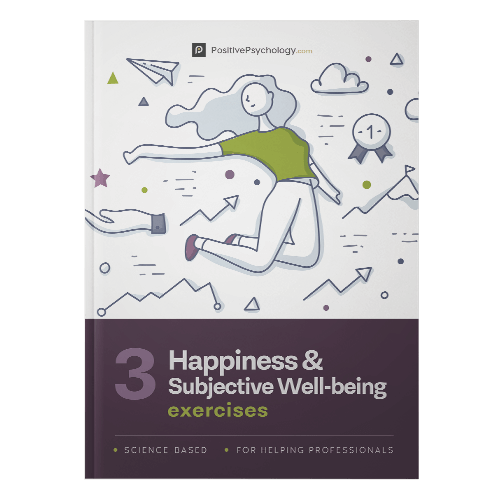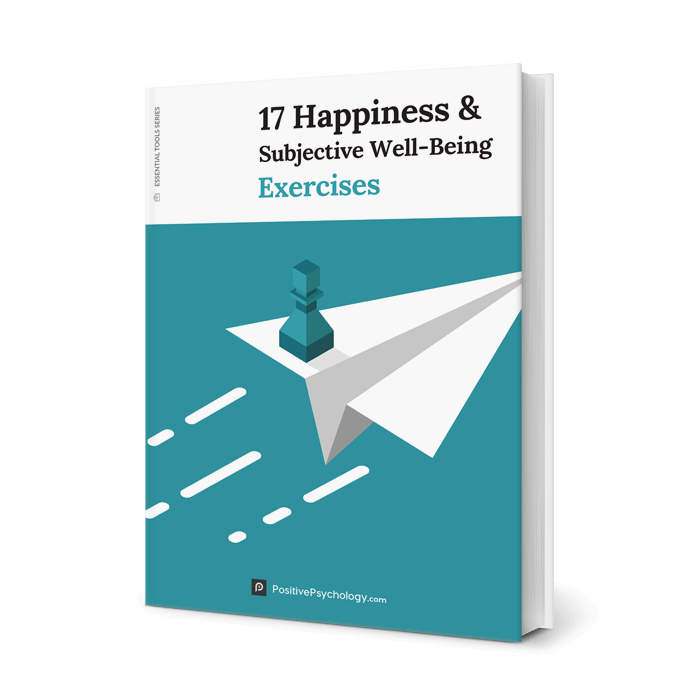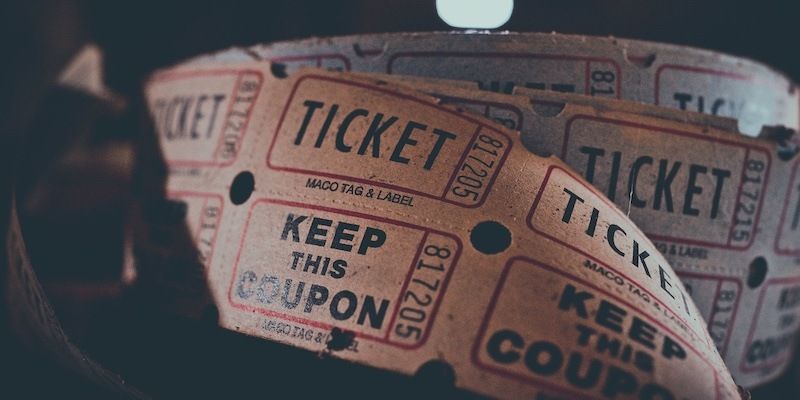4 Scales to Measure Satisfaction with Life (SWLS)
 Reflecting on our sense of happiness in different key areas of life can be difficult, especially if our life is seemingly all going well.
Reflecting on our sense of happiness in different key areas of life can be difficult, especially if our life is seemingly all going well.
Sometimes feelings of unhappiness or dissatisfaction just seem to find us, and it’s up to us to take the time to explore why this might be.
How you do that will depend on a number of different things, but if you’re struggling to get to grips with it, there are plenty of psychology tools and resources to help.
One of those tools is the Satisfaction With Life Scale (SWLS), and in this article, we’re going to take a closer look at what this is and what it can do for you.
Before you continue, we thought you might like to download our three Happiness & Subjective Wellbeing Exercises for free. These detailed, science-based exercises will help you or your clients identify sources of authentic happiness and strategies to boost wellbeing.
This Article Contains:
- The Satisfaction With Life Scale
- What Does the Questionnaire Measure Exactly?
- How Does the Scoring Work?
- A Look at the Reliability and Validity of the Test
- About Ed Diener and the Authors
- The Wheel of Life by PositivePsychology.com
- Student’s Life Satisfaction Scale (SLSS)
- The Multidimensional Student’s Life Satisfaction Scale (MSLSS)
- A Take-Home Message
- References
The Satisfaction With Life Scale
The Satisfaction With Life Scale (SWLS) was first created by researchers Diener, Emmons, Larsen, and Griffin (1985) and published in an article in the Journal of Personality Assessment.
The scale was developed as a way to assess an individual’s cognitive judgment of their satisfaction with their life as a whole. The SWLS is a very simple, short questionnaire made up of only five statements.
Participants completing the questionnaire are asked to judge how they feel about each of the statements using a seven-point scoring system, with 1 being “strongly disagree” and 7 being “strongly agree.”
Below, I’ve outlined what these statements are:
- In most ways, my life is close to my ideal.
- The conditions of my life are excellent.
- I am satisfied with my life.
- So far, I have gotten the important things I want in life.
- If I could live my life over, I would change almost nothing.
Once you’ve assigned a score from 1 to 7 to each of the statements, you tally up your final score for an indication of how satisfied you are overall with life.
As you can see, the SWLS won’t take up a lot of your time to complete! But it can be a really useful instrument in supporting you to reflect on your life, overall satisfaction, and in beginning to think about areas you might need to spend a bit more time exploring.
You can download a full copy of the SWLS, including how to tally and score.
What Does the Questionnaire Measure Exactly?
When it comes to a sense of subjective wellbeing, researchers have asserted that it consists of two main components: the emotional component and the cognitive component (Diener, 1984; Veenhoven, 1984).
The cognitive component has been more closely conceptualized with life satisfaction (Andrews & Withey, 1976), yet despite this, had not previously received much attention for research. Diener et al. (1985) sought to address this and through developing the SWLS, they created a strong tool in the measurement of the cognitive components they felt reflected a subjective sense of wellbeing and life satisfaction.
The SWLS is not designed to help you understand satisfaction in any one specific domain of life, such as your job or relationships; instead, it has been developed to help you get a sense of your satisfaction with your life as a whole.
Although the questionnaire doesn’t measure individual components, it can be an excellent starting point, encouraging deeper thought and exploration of the specific areas of life that may be causing you a sense of dissatisfaction.
How Does the Scoring Work?
The scoring for the SWLS works quite simply, by adding up the total of the numbers you score against each of the statements. So, remembering that 1 = strongly disagree and 7 = strongly agree, the higher your score, the higher your sense of life satisfaction as a whole.
As a guide, your total score means:
- 31–35 = Extremely satisfied
- 26–30 = Satisfied
- 21–25 = Slightly satisfied
- 20 = Neutral
- 15–19 = Slightly dissatisfied
- 10–14 = Dissatisfied
- 5–9 = Extremely dissatisfied
Pavot and Diener (2013) created a more in-depth description of what your score means for your sense of life satisfaction. Very briefly, we’ve written up what they had to say, but it’s worth accessing the original documents.
- 31–35 Extremely satisfied
If you score this high on the SWLS, it means you have a strong love of your life and feel that things are going really well for you. This does not mean to say that you feel your life is perfect, but you are content with how things are and/or feel any challenges are temporary and can be managed.
A high score does not indicate that you are complacent about your sense of satisfaction, and it is likely you understand that challenge is a pathway to growth and greater satisfaction.
- 26–30 Satisfied
If you score in this range, you likely feel that most things in your life are going really well, but there may be one or two key areas you wish to change. You understand that your life is not perfect and respect that any challenges are also an area for further growth and exploration.
- 21–25 Slightly satisfied
If you score in this margin, you’re in good company. The researchers assert that this is where the majority of people score themselves. This score means you are generally satisfied, on an average day-to-day basis; however, there are areas you’d really like to improve.
Rather than there being one or two things that you feel would give you greater satisfaction, you might feel that small improvements across all domains of your life would lead to a higher sense of life satisfaction.
- 20 Neutral
A score of 20 – bang in the middle of the scale – means you’re likely pretty neutral about your sense of satisfaction about your life. You might not give too much thought to what does or doesn’t need improving, and you’re quite content where you are.
- 15–19 Slightly dissatisfied
A score in this range might mean that you tend to feel dissatisfied more than satisfied on a day-to-day basis, and there are several significant areas for improvement. It might also indicate that you’re generally content, but there is one area of life where you feel deeply unsatisfied, which is creating a lower score.
A score in this margin requires further thought and reflection on where improvements need to be made to increase your sense of satisfaction.
- 10–14 Dissatisfied
A dissatisfied score tends to mean you’re feeling substantially dissatisfied about your current circumstances. This might be deep dissatisfaction across all areas of life or that two or three areas are far worse than the others.
It’s worth reflecting to see if your dissatisfaction is due to a recent event or situation, which may be temporary, or if this is a chronic experience because you are not living the life you truly want.
- 5–9 Extremely dissatisfied
As you may have guessed, a score at the very low end of the scale means that you are extremely dissatisfied with your current life circumstances. Again, if this score is due to a recent hard blow in life, such as bereavement, then things may get better over time with the right support.
However, a score this low tends to be an indication of dissatisfaction across multiple areas of life and is a good starting point to begin reflecting on why that might be.
A Look at the Reliability and Validity of the Test
The SWLS is one of the most widely used measurements for life satisfaction. The shortness and ease of being able to administer the scale to achieve foundation results is key to this, but how reliable does that actually make it?
In developing the scale, Diener et al. (1985) tested it widely and reported that it does have good psychometric properties, as well as a high test–retest coefficient (meaning participants who completed the scale more than once demonstrated the same results consistently).
Further research has confirmed this reliability against other measures of life satisfaction (Pavot et al., 1991, Pavot & Diener, 2008) as well as other measures for happiness (Lyubomirsky & Lepper, 1999). It has also correlated well with scales measuring the meaning of life (Steger et al., 2006) and scales measuring hope (Bailey & Synder, 2007).
Several other studies have also sought to use the scale across different cultural groups to test its validity, with positive results. Galankis et al. (2017) used the scale across a sample of 1,797 Greek natives and found their results in line with the original researcher’s studies, as well as other studies exploring cross-cultural uses for the SWLS.
The only part of the scale that has been questioned in the research is the use of the fifth statement, as researchers believe it has a weaker association with life satisfaction and instead causes participants to reflect on the desire to change rather than their current sense of life satisfaction (Pavot & Diener, 1993).
About Ed Diener and the Authors
Lead researcher for the SWLS, professor Ed Diener, was sometimes referred to by his nickname ‘Dr. Happiness,’ owing to his astonishing body of research and academic contributions to the study of happiness and wellbeing.
He was a professor of psychology at the University of Virginia and University of Utah, as well as a senior scientist with the Gallup Organization. He published over 350 academic articles and books and was also the editor of three scientific journals.
As well as happiness and life satisfaction, Diener studied the factors that influence these two areas, including financial health, family upbringing, personality, relationships, and work. He studied these topics across 166 different nations and explored some of the cultural components behind individual happiness.
The other researchers and authors of the SWLS include:
- Robert A. Emmons: A global leading expert and researcher on gratitude. He is currently a professor of psychology for the University of California and the founding editor-in-chief for The Journal of Positive Psychology. Emmons has also authored several books, including The Little Book of Gratitude.
- Randy J. Larsen: A highly regarded expert and academic in the field of positive psychology, Larsen is the William R. Stuckenberg Professor of Human Values and Moral Development, as well as the chair of the psychology department with Washington University. His research has focused on emotions, specifically exploring how we experience emotions differently as individuals.
What you need to be happy by Professor Ed Diener
Where Can You Find the SWLS?
The SWLS is widely available for free online, and while there are a few slight variations, each has the same outcome or measurement at its heart.
One of the best places to find the scale and its scoring is on the Ed Diener Lab website.
The Wheel of Life by PositivePsychology.com
While the SWLS can offer you an indication of your life satisfaction on a more overall scale, there are other tools and resources that can help you to further explore your sense of satisfaction in specific domain areas of your life.
One such tool is the wheel of life (Whitworth et al., 1998).
Once you have your score from the SWLS, you can then begin to reflect more fully on where you might like to make changes to build a greater sense of life satisfaction.
This tool will help you do that, as it requires that you identify the different life domains that are important to you – such as career, family, and relationships – and to then give each of these individual domains a rating from 1 to 10, with 1 being “not at all satisfied” and 10 being “completely satisfied.”
PositivePsychology.com has put together a free ready-to-use resource with a Wheel of Life containing 10 key domains for life satisfaction.
These are:
- Money & finance
- Career & work
- Health & fitness
- Fun & recreation
- Environment
- Community
- Family & friends
- Partner & love
- Growth & learning
- Spirituality
The wheel is a fantastic resource from the SWLS, as not only does it encourage you to think more deeply about where you might be dissatisfied with life, it also creates a great visual representation.
Once you have your scores for each of the 10 domains, you can reflect on where you have given the lowest scores, why these are low scores, and what you might be able to do to start making positive changes and improve your sense of life satisfaction.
Ask yourself:
- Why does this domain need attention?
- What would it take to raise your satisfaction with one score in this domain?
- What can you do to raise your satisfaction in this domain?
Student’s Life Satisfaction Scale (SLSS)
The Student’s Life Satisfaction Scale (SLSS) is relatively similar to the SWLS, except it was purposefully designed to be used with children and young people aged 8–18 years old (Huebner, 1991).
It contains seven statements and asks young people to give each statement a score from 1 to 6, with 1 being “strongly disagree” and 6 being “strongly agree.”
The exception with the SLSS is that the last two questions are reverse scored (so 1 becomes “strongly agree” and 6 becomes “strongly disagree”).
There are a few different variants, but the statements are along the following lines:
- My life is going well.
- My life is just right.
- I would like to change many things in my life.
- I wish I had a different kind of life.
- I have a good life.
- I have what I want in life.
- My life is better than most kids.
As with the SWLS, when each statement has been assigned a score, a summary total is calculated to provide a numerical guide to the student’s sense of life satisfaction.
The Multidimensional Student’s Life Satisfaction Scale (MSLSS)
Following on from the SLSS, Huebner (1994) went on to create the Multidimensional Student’s Life Satisfaction Scale (MSLSS). The MSLSS is a longer scale assessment for measuring students’ satisfaction with life.
It contains 40 items/statements and can be used either with individuals or in a group setting.
Participants are asked to rate their response to the statements using the following numerical grading scale:
1 = Never
2 = Sometimes
3 = Often
4 = Almost always
The MSLSS was developed in response to a growing interest in promoting positive psychological wellbeing among young people and students (Sarason, 1997). With its use, Huebner hoped to:
- Create an individualized profile of a child’s life satisfaction across specific domains
- Provide an assessment of general life satisfaction
- Demonstrate acceptable and reliable psychometric properties
- Show the meaningfulness of the five specific domains it covers: family, friends, school, living environment, and self
- Provide a tool that can be used effectively with a wide range of young people, across different ages
Below, I have provided a brief outline of the types of statements that it includes:
- Family:
- I enjoy being at home with my family.
- My family gets along well together.
- Friends:
- My friends are nice to me.
- My friends are great.
- School:
- School is interesting
- I learn a lot at school.
- Living environment:
- I like where I live.
- I like my neighbors.
- Self:
- I am fun to be around.
- I like myself.
To score the MSLSS, you tally up the total score for each specific domain. A higher score indicates a higher level of life satisfaction – similar to the SWLS.
You can also compare domains by tallying the individual scores and then dividing the score by the number of statements in that specific section, to create a mean score.
You can find out more about the MSLSS and get a copy of the full 40 statements and scoring instructions.
A Take-Home Message
I hadn’t come across the SWLS before researching and writing this article, and I have found it a great tool to use personally. Its ease and accessibility mean everyone can benefit from the foundational insights it might offer you about how you feel about your current life situation.
If there’s one thing I’d like you to take away from this article, it’s that the SWLS and the wheel of life are just the beginning. Use them as resources to help your thought processes and be sure to reflect on your results. We are all in control of our own life satisfaction; if yours isn’t quite where you’d like it to be, you have the ability to change that.
What did you think of the SWLS, and has it helped you? I’d love to hear your thoughts in the comments.
We hope you enjoyed reading this article. Don’t forget to download our three Happiness Exercises for free.
- Andrews, F. M., & Withey, S. B. (1976). Social indicators of well-being America’s perception of life quality. Plenum Press.
- Bailey, T. C., & Snyder, C. R. (2007). Satisfaction with life and hope: A look at age and marital status. The Psychological Record, 57(2), 233–240.
- Diener, E. (1984). Subjective well-being. Psychological Bulletin, 95(3), 542–575.
- Diener, E., Emmons, R. A., Larsen, R. J., & Griffin, S. (1985). The Satisfaction With Life Scale. Journal of Personality Assessment, 49(1), 71–75.
- Huebner, E. S. (1991). Initial development of the Student’s Life Satisfaction Scale. School Psychology International, 12(3), 231–240.
- Huebner, E. S. (1994). Preliminary development and validation of a multidimensional life satisfaction scale for children. Psychological Assessment, 6(2), 149–58.
- Galankis, M., Kakioti, A., Pezirkianidis, C., & Karakasidou, E. (2017) Reliability and validity of the Satisfaction with Life Scale (SWLS) in a Greek sample. The International Journal of Humanities & Social Studies, 5(2).
- Lyubomirsky, S., & Lepper, H. S. (1999). A measure of subjective happiness: Preliminary reliability and construct validation. Social Indicators Research, 46(2), 137–155.
- Pavot, W., Diener, E., Colvin, C. R., & Sandvik, E. (1991). Further validation of the Satisfaction With Life Scale: Evidence for the cross-method convergence of well-being measures. Journal of Personality Assessment, 57(1), 149–161.
- Pavot, W. & Diener, E. (1993). Review of the Satisfaction With Life Scale. Psychological Assessment, 5(2), 164–172.
- Pavot, W., & Diener, E. (2008). The Satisfaction With Life Scale and the emerging construct of life satisfaction. The Journal of Positive Psychology, 3(2), 137–152.
- Pavot, W., & Diener, E. (2013). Happiness experienced: The science of subjective well-being. In S. A. David, I. Boniwell, & A. Conley Ayers (Eds.), The Oxford handbook of happiness (pp. 134–151). Oxford University Press.
- Sarason, S. D. (1997). Forward. In R. Weissberg, T. P. Gullotta, R. L. Hampton, B. A. Ryan, & G. R. Adams (Eds.), Enhancing children’s wellness (vol. 8, pp. ix–xi). Sage.
- Steger, M. F., Frazier, P., Oishi, S., & Kaler, M. (2006). The Meaning in Life Questionnaire: Assessing the presence of and search for meaning in life. Journal of Counseling Psychology, 53(1), 80–93.
- Veenhoven, R. (1984). Conditions of happiness. Kluwer Boston Academic.
- Whitworth, L., Kimsey-House, H., & Sandahl, P. (1998). Co-active coaching. Davies-Black.
Let us know your thoughts
Read other articles by their category
- Body & Brain (49)
- Coaching & Application (57)
- Compassion (26)
- Counseling (51)
- Emotional Intelligence (24)
- Gratitude (18)
- Grief & Bereavement (21)
- Happiness & SWB (40)
- Meaning & Values (26)
- Meditation (20)
- Mindfulness (45)
- Motivation & Goals (45)
- Optimism & Mindset (34)
- Positive CBT (29)
- Positive Communication (20)
- Positive Education (47)
- Positive Emotions (32)
- Positive Leadership (18)
- Positive Parenting (4)
- Positive Psychology (33)
- Positive Workplace (37)
- Productivity (17)
- Relationships (46)
- Resilience & Coping (36)
- Self Awareness (21)
- Self Esteem (38)
- Strengths & Virtues (32)
- Stress & Burnout Prevention (34)
- Theory & Books (46)
- Therapy Exercises (37)
- Types of Therapy (64)





What our readers think
hi, can i use your scale for my research work
Hi Isha,
Which scale are you interested in using? Let me know, so I can assist you further!
Warm regards,
Julia | Community Manager
Dear Sir, I hope you are in good health and spirits.Sir,I am a student of BS Psychology from APWA college, Lahore.I am going to conduct research on Life satisfaction which is the part of partial fulfillment of my degree. I want to use Life satisfaction Inventory: development and validation of scales for the measurement of life satisfaction in order to conduct research. Hence,I want to use your questionnaire. I have found you very generous in letting researchers and students use your tool. Kindly give me permission to use the questionnaire as soon as possible due to the requirements of my research work. It’s a humble request to you.
Thank you.
Hi Faiqa,
This scale is freely available to use and a copy of it with scoring information can be accessed here.
Hope this helps!
Kind regards,
Julia | Community Manager
Mam I am doing a counseling course. Could you please suggest a scale to measure life satisfaction in retired college teachers?
Hi Matthew,
I would use the SWLS unless there’s a particularly compelling reason not to (e.g., if there’s some specific characteristic of a retired college student sample you want to assess).
– Nicole | Community Manager
Hi.. Hope you are doing good.. I am doing research for my BS program.. I need your help to suggest me good scale for life satisfaction in high achievers.. As my topic for research is Role of parenting style and coping skills on life satisfaction in high achievers.. Can you please suggest me an authentic cite for the scale please?
Thank you!
Hi Rimsha,
By “high-achievers,” I assume you mean your sample will be school-aged students? If so, I suspect the SLSS or MSLSS would be suitable.
– Nicole | Community Manager
Good day, Ma’am.
I would like to ask if you can recommend us a Life Satisfaction Scale specific for College Students that belong to Low-Income families. Hoping to receive a response from you. Thank you.
Hi Adrian,
It sounds like the Student’s Life Satisfaction Scale (SLSS), discussed in the post, is likely to be suitable for your research 🙂
Hope this helps!
– Nicole | Community Manager
How to interpret means of mslss?
Hi Ma. Antionette,
This stands for The Multidimensional Students Life Satisfaction Scale 🙂
– Nicole | Community Manager
Please madam provide me life satisfaction scale of 10 items
Hi Muhammad,
Sorry, it appears most scales are either five items or more than ten.
If there’s some flexibility around the number of items (and you let me know the scale’s specific purpose), I might be able to recommend something!
– Nicole | Community Manager
I am looking for a homelife (family interaction) satisfaction scale. Do you know a scale that may help with this?
Hi Dean,
Check out the appendix of Zabriskie & McCormick (2003) for the quick, five-item Satisfaction with Family Life Scale (SWFL).
Hope this helps, but let me know if you’re looking for something slightly different.
– Nicole | Community Manager